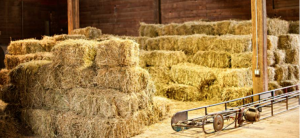 The color of horse hay is very useful in determining the quality of the hay. Methods of curing and storing hay greatly influence its appropriateness for horses.
The color of horse hay is very useful in determining the quality of the hay. Methods of curing and storing hay greatly influence its appropriateness for horses.The key to properly cured hay lies predominantly in moisture content. For best results, hay should not be baled until there is less than 20% moisture. Hay baled too wet might mold, heat, and pose a fire risk. Conversely, hay baled too dry might lose its nutritional value through broken or fallen leaves. Rain is the bane of a hay harvester’s existence, and it can cause extensive nutrient losses, especially to vitamins A and E, protein, and certain carbohydrates.
Though the color of hay is not the end-all, be-all method for determining hay quality (that would be forage analysis by a laboratory), color is a useful indicator of nutritive value.
Green:
Without question, the most desirable color of hay is bright green. Greenness indicates the hay was not subjected to any adverse conditions during curing or storage, thereby suggesting the forage is nutritious and free of molds. Green hay is often rife with carotene, a precursor to vitamin A, and vitamin E.
Yellow:
If hay is yellow, there is a likelihood that it was overmature when cut or was exposed to rain during the curing process. If the hay was rained on, it is not only susceptible to leaching of nutrients but also mold proliferation, which can cause gastrointestinal and respiratory problems such as colic, coughing, or heaves. In other instances, yellowing might be due to sun-bleaching, which occurs when stored hay is exposed to direct sunlight. Sun-bleaching decreases carotene content and palatability of the discolored hay. Sun damage usually affects only the outside of bales, so much of the hay in these bales is probably salvageable.
Brown:
Nutritious hay is rarely, if ever, brown. If a tobacco-like odor accompanies extremely off-colored hay, this is likely due to overheating during storage caused by excessive moisture and fungal growth. Palatability of low-quality brown hay is usually poor. Due to the predisposition to mold and unpalatability, this hay should not be fed to horses.
Not all horses require bright green, nutrient-dense hay. In fact, equine nutritionists are adamant that forage selection be based on individual needs. An overweight pony does not need to stand knee-deep in fluorescent alfalfa (lucerne) for two-thirds of the day, and a thinnish lactating mare needs more than last year’s yellowing meadow grass to keep her in milk.
Other factors also affect hay quality including plant type (grasses versus legumes), stage of maturity, leaf-to-stem ratio, and presence of mold, weeds, and other foreign material.
Would you like more information about hay diets? Contact us at J & J Farms by clicking here!
Article brought to you by KER.
